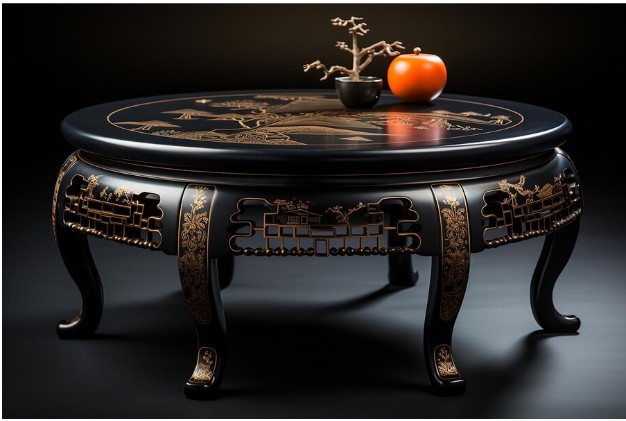Elegance Preserved: The Timeless Allure of Wooden Antique Tables

Wooden antique tables stand as more than just furniture; they are testaments to craftsmanship, history, and the enduring beauty of natural materials.
From intricately carved legs to richly patinated surfaces, these pieces invite us to step into the past while adding a touch of classic sophistication to contemporary spaces.
In this exploration, we delve into the world of wooden antique tables, unraveling their unique characteristics, the artistry behind their creation, and tips for preserving their timeless allure.
1. The Craftsmanship: Artistry in Wood
Antique tables crafted from wood boast a level of artistry that reflects the skill and dedication of master craftsmen from bygone eras.
Each table tells a story through its design, showcasing the craftsmanship of artisans who meticulously carved, turned, and joined wood to create functional pieces that doubled as works of art.
Intricate Wood Carvings:
Many antique tables feature intricate wood carvings that range from floral motifs to more elaborate scenes and patterns.
These details not only serve a decorative purpose but also highlight the artisan’s mastery over the material.
Elegant Turned Legs:
The legs of wooden antique tables often exhibit elegant turning, a technique where the wood is shaped on a lathe to create decorative curves and profiles.
This craftsmanship adds a sense of refinement and grace to the overall design.
Joinery Techniques:
Traditional joinery techniques, such as dovetail and mortise-and-tenon joints, contribute to the durability and longevity of antique wooden tables.
These methods, perfected over centuries, result in sturdy constructions that have withstood the test of time.
2. Types of Wooden Antique Tables
Farmhouse Tables:
Farmhouse tables, with their rustic charm and robust construction, are a popular type of wooden antique table.
Crafted for practicality, these tables often feature simple designs with wide plank tops and sturdy legs, making them well-suited for family gatherings and communal meals.
Victorian Parlor Tables:
Characterized by ornate detailing and refined craftsmanship, Victorian parlor tables were prominent during the 19th century.
These smaller tables were often placed in sitting rooms or parlors, serving as platforms for decorative items or a place for a quiet tea.
Drop-Leaf Tables:
Practical and versatile, drop-leaf tables feature hinged sides that can be raised or lowered to adjust the size of the table.
This design allows for flexibility in dining spaces, making them a popular choice in antique furniture.
Gateleg Tables:
Gateleg tables, with their hinged legs that swing out like gates, offer a space-saving solution. When not in use, these tables can be folded down to a compact size, making them ideal for smaller rooms.
3. Wood Types and Finishes
Mahogany:
Mahogany is a favored wood choice for antique tables, prized for its rich, reddish-brown hue and fine grain.
This hardwood lends an air of sophistication and warmth to furniture pieces, often enhanced with a polished finish.
Oak:
Oak, with its strong and durable characteristics, was commonly used in crafting antique tables, especially during the Arts and Crafts movement.
Tables made from oak often showcase a more rustic appeal, emphasizing the natural beauty of the wood.
Walnut:
Walnut is celebrated for its dark, chocolate-brown color and smooth grain. Tables crafted from walnut exude a timeless elegance, and the wood often develops a lustrous patina over time.
Cherry:
Cherry wood tables are prized for their reddish-brown hue that deepens with age and exposure to light. Cherry is known for its smooth texture and the ability to take on a beautiful, satiny finish.
4. Preserving the Timeless Beauty
Regular Cleaning:
Gentle and regular cleaning is essential to preserve the beauty of wooden antique tables. Dusting with a soft cloth and occasionally using a mild wood cleaner can help prevent dirt and grime buildup.
Avoiding Direct Sunlight:
Prolonged exposure to direct sunlight can lead to fading and discoloration of wood. Positioning antique tables away from windows or using curtains and blinds can protect them from harmful UV rays.
Appropriate Humidity Levels:
Wood is sensitive to fluctuations in humidity, which can lead to warping or cracking. Maintaining a stable humidity level in the environment, ideally between 40-45%, helps prevent such issues.
Avoiding Harsh Chemicals:
Harsh cleaning chemicals can damage the finish and patina of wooden antique tables. Opt for mild, wood-friendly cleaners, and avoid abrasive materials that can scratch the surface.
5. Incorporating Wooden Antique Tables into Modern Spaces
While antique tables are treasures from the past, they seamlessly integrate into modern interiors, adding character and a sense of history. Here are some tips for incorporating wooden antique tables into contemporary spaces:
Mixing Styles:
Pair an antique table with modern chairs or vice versa to create an eclectic and balanced look. The contrast between old and new can be visually appealing.
Statement Piece:
Allow the antique table to take center stage by keeping the surrounding decor minimalistic. This highlights the unique features and craftsmanship of the table.
Functional Decor:
Use the antique table as a functional decor piece. Displaying books, artwork, or a curated collection of items can transform it into a focal point in the room.
Color Harmony:
Consider the color palette of the room when choosing an antique table. Harmonizing the tones of the wood with the overall color scheme creates a cohesive and inviting atmosphere.
Conclusion: A Legacy in Wood
Wooden antique tables are not just pieces of furniture; they are embodiments of history, artistry, and enduring elegance.
Their presence in modern homes serves as a bridge between the past and the present, adding a layer of authenticity and charm to contemporary living spaces.
As we cherish these timeless treasures, we celebrate the craftsmanship that went into their creation, ensuring that their legacy in wood continues to captivate and inspire for generations to come.




